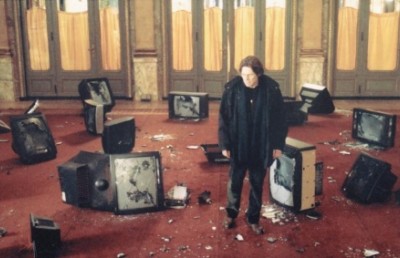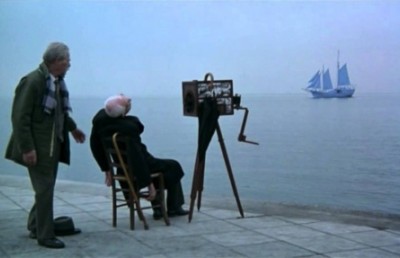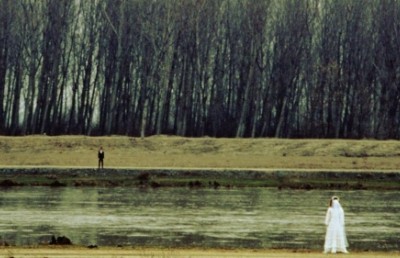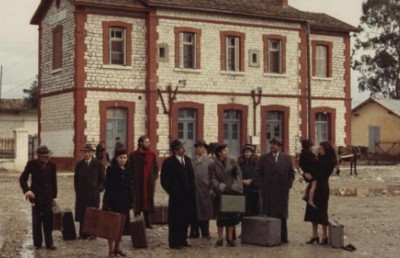Theo Angelopoulos: On the Road between Story and History
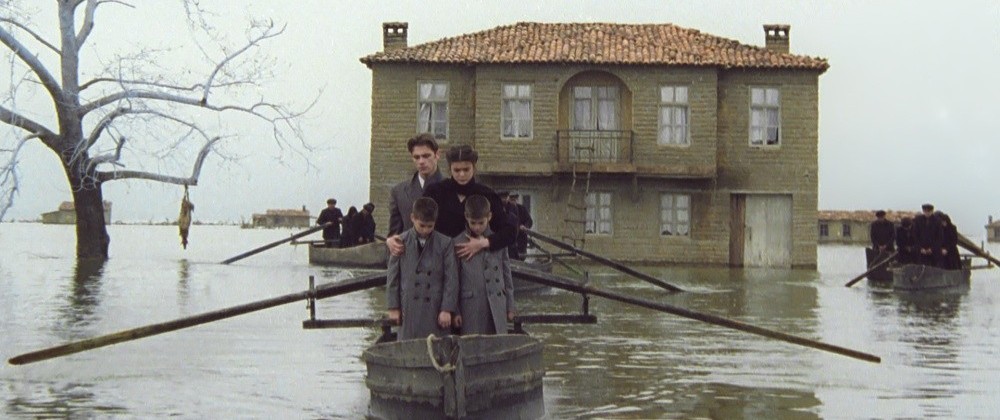
(Translated from French by Frédéric St.-Hilaire)
With his films, Theo Angelopoulos’ creates a mixture of historical and introspective cinema. In his early, more politically inclined films, this leads to a kind of Kantian sentiment of the sublime, where, through the poetry of the narration and the disarray of his characters, we can’t help but feel anxious facing the socio-political context of a Greece still haunted by the ghosts of its past. In his films that concentrate on one or two characters rather than on a group, something manifests itself which could be likened to a representation of the Heideggerian Dasein (“existence”), where the characters live a conflict more ontological than political, even if politics is never really far away. Whether confronted with the passage of time (Eternity and a Day), or in search of lost pieces of their History (Ulysses’ Gaze), the characters that populate Angelopoulos’ cinema carry in them the weight of the history of modern, and sometimes, given the numerous mythological references littered across his films, ancienti, Greece, allowing him to comment on the ontology of the tight-knit relationship between History with a big H and story, both central to the narratives of his films.
If the early Angelopoulos films all take place in the past, this does not preclude them from being his most political. For him, the political past of the Greek people is reflected in their present identity. This time-transcending mirror Angelopoulos offers his countrymen is a type of therapy, revisiting the past as psychoanalysts often do with their patients, but here the director does it with an entire society. If Greece has often been rendered passive and apathetic by its politics and the weight of its sad history, the cinema of Angelopoulos is one which extolls the virtues of taking action, and never giving up.
History as the essence of society
Gilles Deleuze defines the essence of a thing as being “that which without, the thing can neither be nor be conceived.” 1 In that sense, History is clearly the essence of the contemporary society that Angelopoulos depicts, since it bridges past and present and hides in itself the causes of which the collective conscience can only apprehend the effects. For Spinoza, human conscience knows the effects of a cause, but what it interprets as causes of these effects are in fact effects of other causes to which human conscience does not have full access, but which are hidden in their essence. The historian’s work that Angelopous carries out relates to a specific search within the essence of his community: its political past.
Long take aesthetic
Angelopoulos’ use of the long take reflects his desire to create a depth in time which leads to a crystallization of duration which transforms the present into memory. 2 Despite the shifting between eras in his films, story and History are always told in the present tense, according to the viewpoint of the contemporary spectator, and with a message that remains actual. The long take allows him to extract “pure time” from his film, and to return the past to the present.
The typical Angelopoulos shot is akin to a romantic painting. It is in some ways a living painting on which sentiments of the sublime are expressed in a manner more theatrical than cinematographic, impregnating themselves in a temporality thanks to filmic duration. Similarly, we can think of Angelopoulos’ long dolly shots as inspired by the cinema of Alain Resnais – notably Last Year at Marienbad (1961) and Van Gogh (1948). Angelopoulos’ way of travelling between different units of time inside the same shot, which has become his trademark, is similar to the technique used by Resnais and Alain Robbe-Grillet, provoking what Deleuze calls “dissolution of the image-action.” 3 But this dissolution of classical narrative continuity works in different ways. With Resnais, this dissolution is applied to the benefit of an architectural reconstruction of time, whereas with Robbe-Grillet, the goal is to erase time to create a “perpetual present.” 3 In Angelopoulos’ films, arriving at this perpetual present seems to be what the director is after, in order to be able to confront History with story. The desire of Angelopoulos to narrate History in the present tense is simply due to the fact that he considers that History should not be relegated to the past, since it is guarantor of the present. The extreme depth of field in his shots is employed so that the story of the character who advances from the background of the shot to the foreground actually becomes the History of the character who moves from the background to the foreground. This nuance is very important since the long take acts as a relay between those two moments: the beginning and end of the shot. And if sometimes the in-between might appear banal for the story, it is vital in demonstrating the raison d’être of the History, since it allows for the understanding of the link between the beginning of the shot (which is of the domain of the past) and the end of the shot (which is of the domain of the present in the instant where we see it). The formal aspect of the long take therefore comes to support the socio-political message of Angelopoulos’ cinema, which criticizes the servitude towards the present and the indifference of Greek society when facing its sad, repressed History. The duration defines itself as being like the perseverance of existence. 5 The duration of Angelopoulos’ shots reinforce the desire to help History survive and to keep it in the present rather than relinquish it to the past.
Reconstruction (1970)
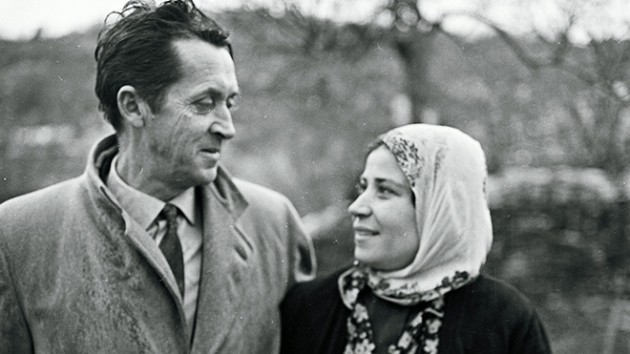
Reconstruction
Angelopoulos’ first feature, Reconstruction, does not deal with Greek history, but it foreshadows his investigative approach toward the past of his people. The film is to some extent an investigation of a murder which took place in a small Greek village, but the reconstruction in which Angelopoulos indulges allows him to take a closer look at the people he films.
If Reconstruction offers a contemporary narrative rather than portraying an era of Greek history, it still reflects on the way stories (or histories) are told, and the film gains resonance when placed in the context of Angelopoulos’ treatment of History in his other work. The film opens with two different reconstructions of a murder where the police have two hypotheses on the unfolding events of the crime. Angelopoulos reconstructs events from the testimony of the two defendants, from the court documents, and from the “facts” related by the journalists who covered the story. If those three reconstructions, made from three different viewpoints, teach us more about this story, we are still no closer to learning what really happened in the house. Angelopoulos wants to reaffirm that he does not pretend in his film to reveal the “facts” of the case, but simply tells a story. We will see in this film, as well as in his future films, that story is merely a pretext to create poetry. This is particularly true of the final long take, filmed with total gentleness, with the camera never allowed to reveal the “truth,” but instead allowing the audience to accept the mysterious beauty of the story’s defused intrigue 6 and come to terms with the lack of answers to the questions.
In fact, Angelopoulos was not presenting three but four viewpoints in his film, because the poetic character of his images is a viewpoint in itself. The camera tends to look not directly at a news event, but at contemporary Greece through the cinematographic commentaries present in the film. Notably, the images of Reconstruction powerfully condemn the village and its uneducated inhabitants for their adherence to the societal profile promoted by the “colonels’ dictatorship” who seized power in Greece during the making of the film. That cynical note helps Angelopoulos distance his film from the image of Greece as a tourist paradise. Instead, he shows us the real Greece with its social problems, not the Greece of postcards, which does everything to hide its faults.
Angelopoulos’ reconstruction exercise does not pretend to write or rewrite Greek history. He highlights this point in both this film and the one he would direct immediately after, Days of ’36 (1972). In these two films, all important information related to the historical facts and where the truth is hidden or ambiguous, is not invented by the director; he maintains a distanced stance. It is with an outsider’s gaze that he reconstructs the crime at the end of his debut film, while in Days of ’36, we follow the kidnapping of a politician from outside of the room where it takes place.
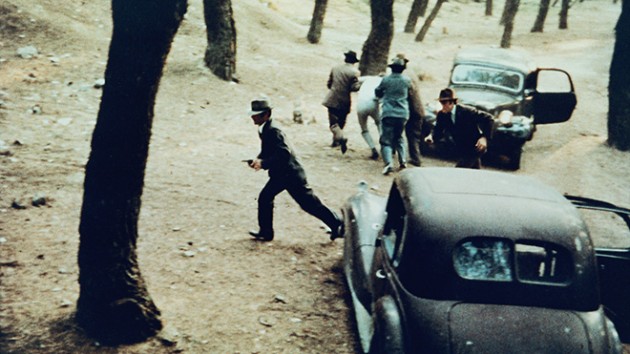
Days of ’36
The Travelling Players (1975) and The Hunters (1977)
The presence of different eras of Greek History in Angelopoulos’ films comes from a desire of the director for History to have a therapeutic effect on his compatriots. His films’ images try to uncover the repressed past of a Greece that was torn apart by political conflicts throughout the twentieth century, and up to the present day.
David Bordwell writes that Angelopoulos tries to uncover the History of his nation in a manner similar to Hungarian director Miklos Jancsò’s use of“mass dynamics and stripped-down spectacle” (“Tony and Theo.” Observations on Film Art). However, Angelopoulos never intended to represent History in a realistic fashion or to reproduce it faithfully, but aimed to make its strength and importance felt through the images and their poetics. In The Travelling Players, he presents a group of theatre actors who travel through time and experience important moments of Greek History. The members of the troupe are at once actors in and spectators to the spectacle of History, and function as audience surrogates who are powerless witnesses to the magnitude of events. The sublime is strongly present here, since the director places us in front of historic facts which provoke a sentiment of powerlessness, absorbing viewers with the depth and duration of shots of memorable grandiloquence.
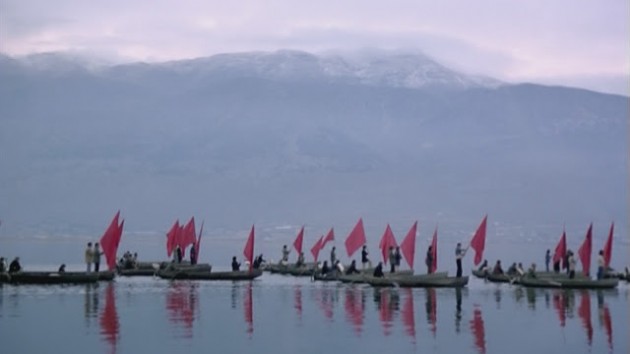
The Hunters
If, in The Travelling Players, the characters travel through History, it is an inverse process that is used in The Hunters, where it is History which visits the characters. A group of hunters discover the corpse of a soldier from a war that ended twenty-five years previously, raising painful memories in a group of petit bourgeois thriving in their totalitarian society. This event, however, also rekindles the fear of a possible revolutionary movement. The narrative unfolds in a series of testimonies where every character tells a story that transports us in time without changing place. In this way, Angelopoulos foregrounds the way a place is inhabited by its history, presenting himself as an archeologist unearthing the past of a specific place.
The Hunters is a film we could qualify as being fantastical since its scenario is more than improbable and its fictitious nature is not hidden. The point of departure for the time travel trips into History is often the stage or behind the scenes of a theatre. Even if Angelopoulos starts from a real History and political context, this reality is artfully transposed into a fantastical context where “the real tends to lose itself into the imaginary.” 7 This imaginary object, which is the still-fresh body of a soldier dead for over twenty years, is not strictly necessary to the film, at least at the level of the screenplay, since Angelopoulos does not need to insert this fantastical touch to legitimize his returns to the past. The imaginary object is used to symbolize that which is not real, something which we can only see in the form of a symbolic imaginary representation, like the man who returns from the past. The bourgeois group, by burying the body of the hunter, “hides that which is not real, that which maybe does not exist, but in fact what they want to bury is their fear, History, which is historical remorse.” 8 The corpse, therefore, serves more to insert the symbolic of the fear of the past more than to advance the story.
The Beekeeper (1986), Landscape in The Mist (1988)
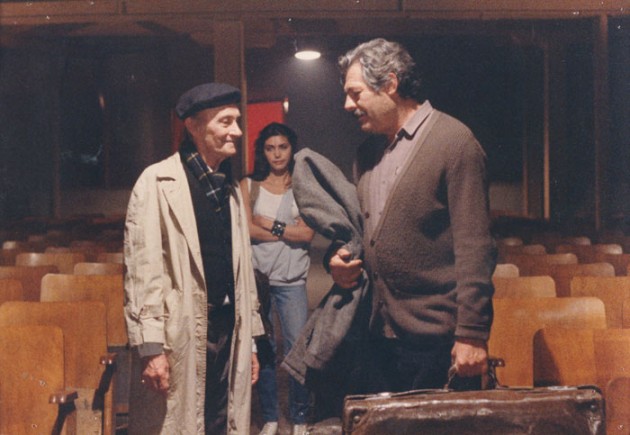
The Beekeeper
The Beekeeper is the Angelopoulos film which strays furthest from the story/History relationship, in order to concentrate on the interiority of its main character, Spyros (Marcello Mastroianni). Nearing death, Spyros seems to want to bid farewell to his loved ones before the end of his story. If, throughout the narrative, a young woman tries to reconnect him to life, the only links he is able to create with her are purely erotic and oriented towards satisfying his narcissistic desires. They are therefore also connected to Spyros’ death wish, since through his lack of concern toward the girl when he rapes her, he continues his process of detachment from life.
The aesthetic treatment of The Beekeeper is also different from his other films. If Angelopoulos still prefers the long take, it is used in another manner. His approach is much less formalist. The classical Angelopoulos shot imposes itself as an historical tableau in which cinematographic duration acts as a realization of man and of the relativity of his story in the face of History, and in which the depth of field, the vanishing point and the moving camera offer the possibility of quantifying this duration and penetrating it. In The Beekeeper, the camera is used to visually articulate the foggy filter that imposes itself between Spyros and the desire for living. In this context, we can interpret the film as representing the existential crisis of a self-questioning director, much in the manner of Federico Fellini when he employed the same actor in 8 ½ (1963).

Landscape in The Mist
Even if the aesthetic of Landscape in the Mist is more faithful to Angelopoulos’ style than The Beekeeper, the films are not entirely dissimilar. First, Landscape in the Mist appears to reaffirm the director’s desire to push politics into the background in order to focus on the individual and second, both films can be considered road movies.
Angelopoulos’ previous films also share some of the codes and aesthetics of the road movie. Characters in road movies typically define or redefine themselves through where they have been or by discovering their origins, and are therefore searching for their essence. This quest is intended to deepen their understanding of their current situation through what they learn about their personal history. Similarly, Angelopoulos’ travel films often tend to define characters through the places they visit, places which often have links to History. If the theme of the voyage has always been present in Angelopoulos’ cinema, it will become even more prevalent as the director places more emphasis on the narratives of individuals faced with History rather than concentrating on communities, as in his early films.
Poetic Wanderings
The theme of wandering is ever present in Angelopoulos’ cinema. His characters often wander aimlessly, which is replicated in the spectators’ response to the film. Faced with the narrative complexity of the films (notably The Travelling Players), the spectator who generally tries to understand everything finally gives up and starts wandering in step with the film. As Bordwell writes:
We rarely know where a character is headed on that walk, or what they see that makes them approach. In a way this technique recalls the thriller or horror film: show the reaction and pan to the cause of it. But with Angelopoulos that cause will tend to be something stupefying in scale, a revelation of a side of the world we haven’t suspected, perhaps a realm closer to surrealism. (Bordwell, “Tony and Theo”).
The journey of Angelopoulos’ characters is often stripped of meaning, with characters only feeling the causes and effects of their departure during the course of their journey. The people they meet offer them a sort of ontological revelation of their presence in the world. In this way, the old man of Landscape in the Mist discovers a new way to look at the world through his encounter with an illegal child immigrant. The surrealism that Bordwell talks about may be a way for Angelopoulos to transcend the reality of a character that limits himself to the border of his point of view and reveal to him the existence of a form of otherness. The surreal image of men crossing the border of his country reveals to the old man the non-sealed nature of his reality, represented by the Greek border and the fog that prevents him from seeing the other side. Similarly, the extreme complexity of The Travelling Players may be explained as a desire to break the linear vision that we have of time in favor of a more poetic one which will touch the spectator as an individual and lead him to think of his relationship to the story less in a factual and explicative fashion and more in an emotional one.
Images we might call surreal frequently appear in Angelopoulos’ cinema. They lend a certain mysticism to the films, perhaps to reinforce the idea of the imaginary already present in The Hunters, or even to give the films a mythic dimension. Mythological references, after all, abound in his cinema, with Ulysses’ Gaze, where Angelopoulos draws a parallel between The Odyssey and his narrative of a man’s voyage into his past via a search for historical documents, merely the most obvious.
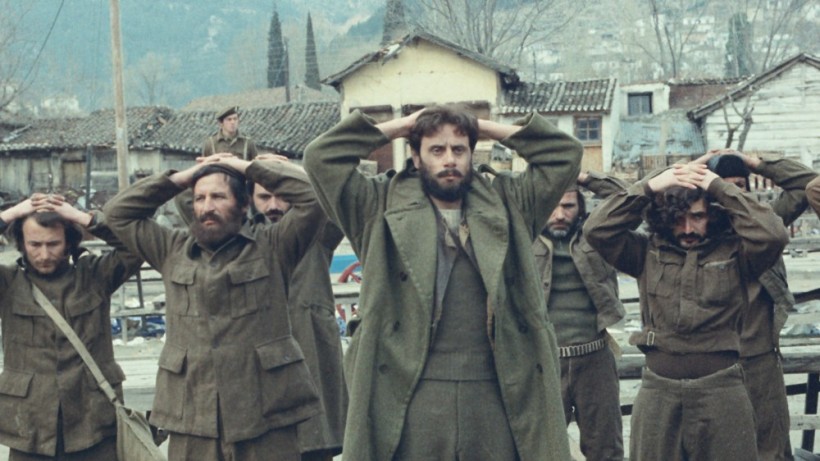
The Travelling Players
Historical Wandering
In his unfinished trilogy, Angelopoulos creates a fusion between the historical and the individual story. In The Weeping Meadow (2004) and The Dust of Time (2008), the characters are strongly influenced by past decisions and the narratives are motivated by, among other things, the feelings of the characters towards the things they did and the things they did not do, sometimes with far-reaching consequences. If, in his first films, Angelopoulos was mindful of History to testify to its importance on the contemporary politics of his country, in his final films, the past proves that certain choices can have dramatic long term repercussions. The sense of the sublime and the romantic that characterize the Angelopoulos shot therefore substitutes itself for an Heideggerian sentiment where the characters finally realize their existence and their power of action in the past, present and future of their world. Whether it is the young lovers’ decision to leave in The Weeping Meadow or the regretful separations and wasted reunions of The Dust of Time, Angelopoulos testifies to the anxiety humans have faced with the simple fact of their existence and of their influence on the world. The abandonment of a “social” cinema for one which focuses more intently on the individual is perhaps a way for Angelopoulos to understand the fear of many of his country’s citizens to engage in political life, as well as their cynicism regarding the future of Greece. In the end, it is possible that Angelopoulos, by inviting spectators to wander through his films, is looking to make them discover and meet the polis, leading them to, as Gilles Deleuze puts it, “believe in this world” they inhabit 9 .
Bibliography
Amengual, Barthélémy. Théo Angelopoulos, une poétique de l’histoire, in Études Cinématographique, Vol 48.
Bordwell, David. “Tony and Theo.” Observations on Film Art, Accessed April 27, 2013, Link
Deleuze, Gilles. “Critique,” L’Image-temps. Cinéma 2, éd. de Minuit, coll. 1985
Deleuze, Gilles. Spinoza philosophie pratique, minuit (coll. reprise), 2003, Paris.
Estève, Michel. “L’histoire au présent,” in _Études Cinématographique, Vol 48.
Notes
- “ce sans quoi la chose ne peut ni être, ni conçue.” Gilles Deleuze. Spinoza philosophie pratique, minuit (coll. reprise), 2003, Paris, 98. ↩
- “Le présent devient mémoire, non point passé mort, mais unité mouvante du devenir, totalisation de l’être, de l’individu, du groupe, du monde.” Barthélémy Amengual. Théo Angelopoulos, une poétique de l’histoire, in Études Cinématographique, Vol 48. ↩
- Ibid, 137. ↩
- Ibid, 137. ↩
- Gilles Deleuze. Spinoza philosophie pratique, 87. ↩
- Terme emprunté à Hélène Tierchant, p. 23 ↩
- Michel Estève. “L’histoire au présent,” in _Études Cinématographique, Vol 48 : 88. ↩
- Ibid. ↩
- “Nous avons besoin d’une éthique ou d’une foi . . . ; ce n’est pas un besoin de croire à autre chose, mais un besoin de croire à ce monde-ci . . . “ Gilles Deleuze. “Critique,” L’Image-temps. Cinéma 2, éd. de Minuit, coll. 1985, p. 225 ↩


